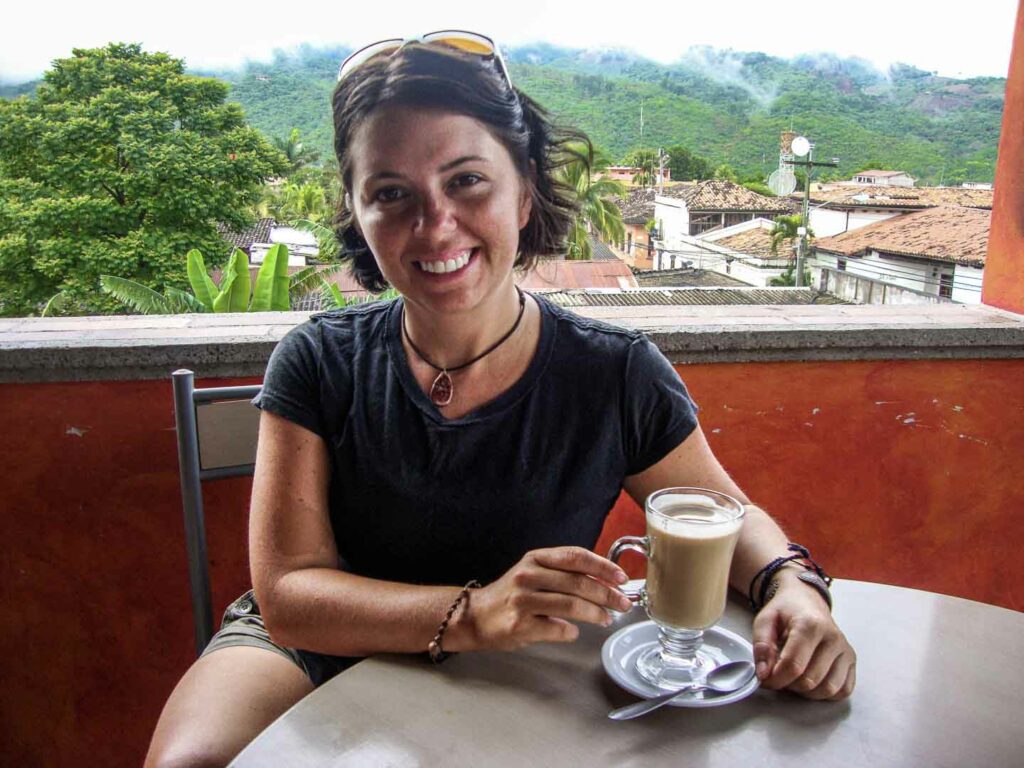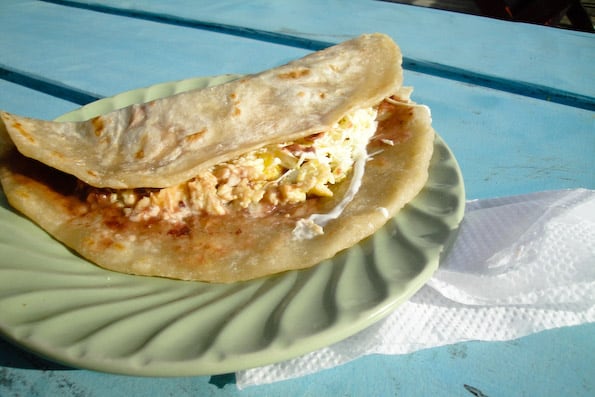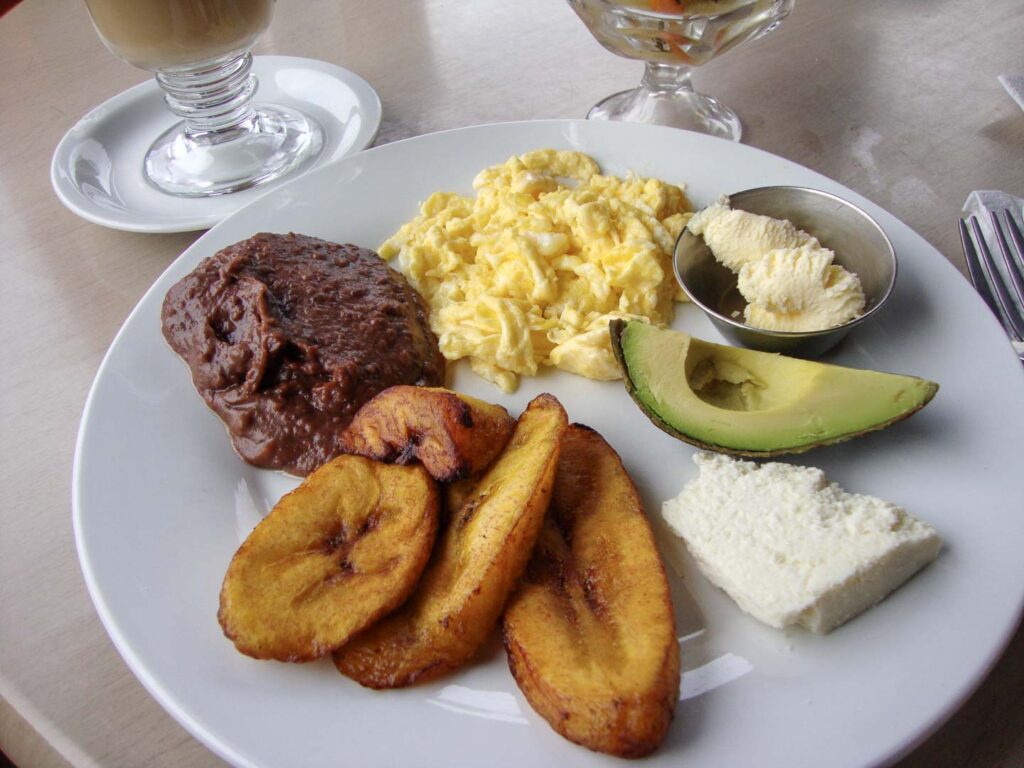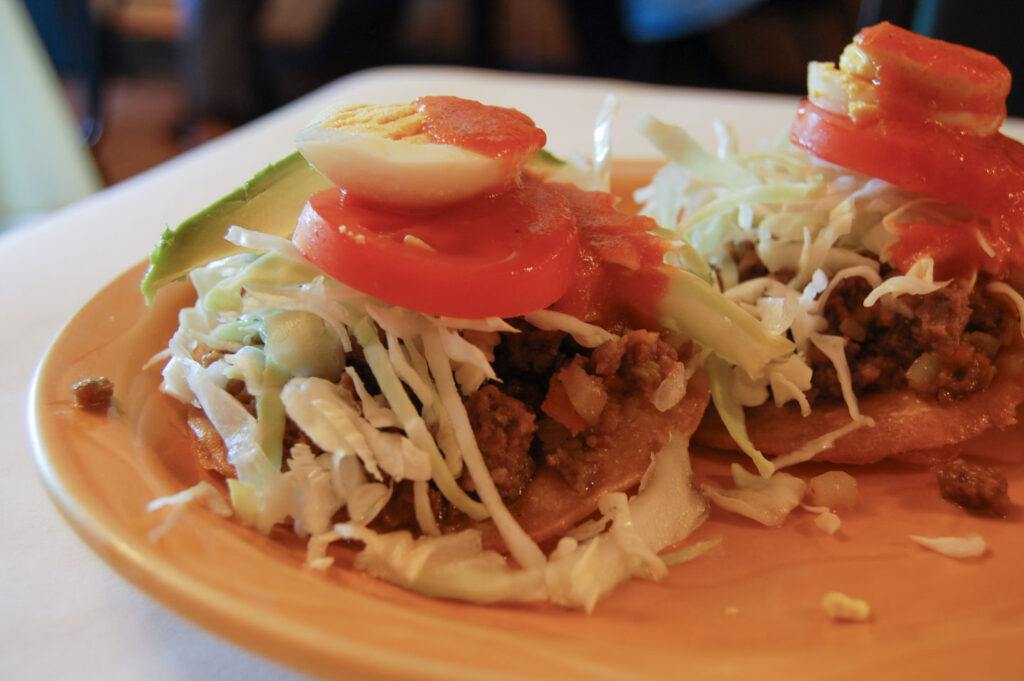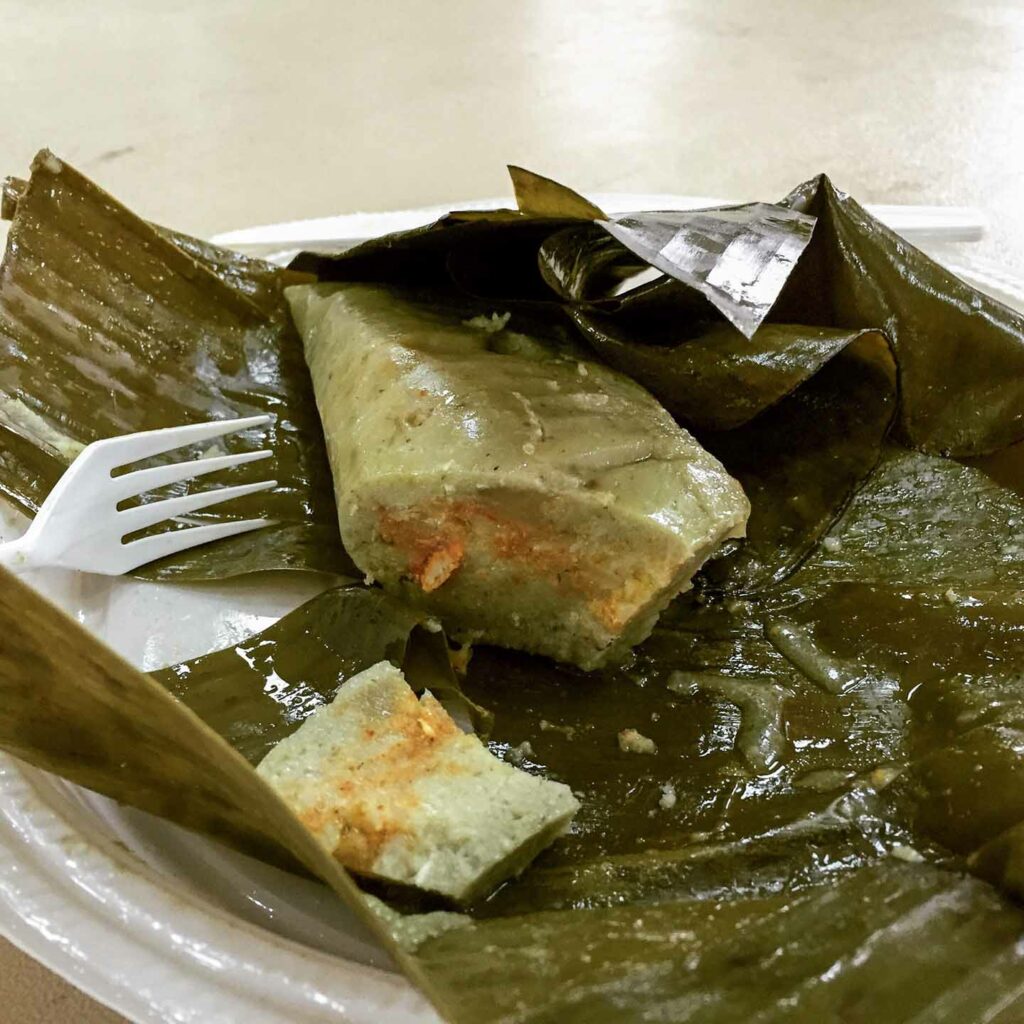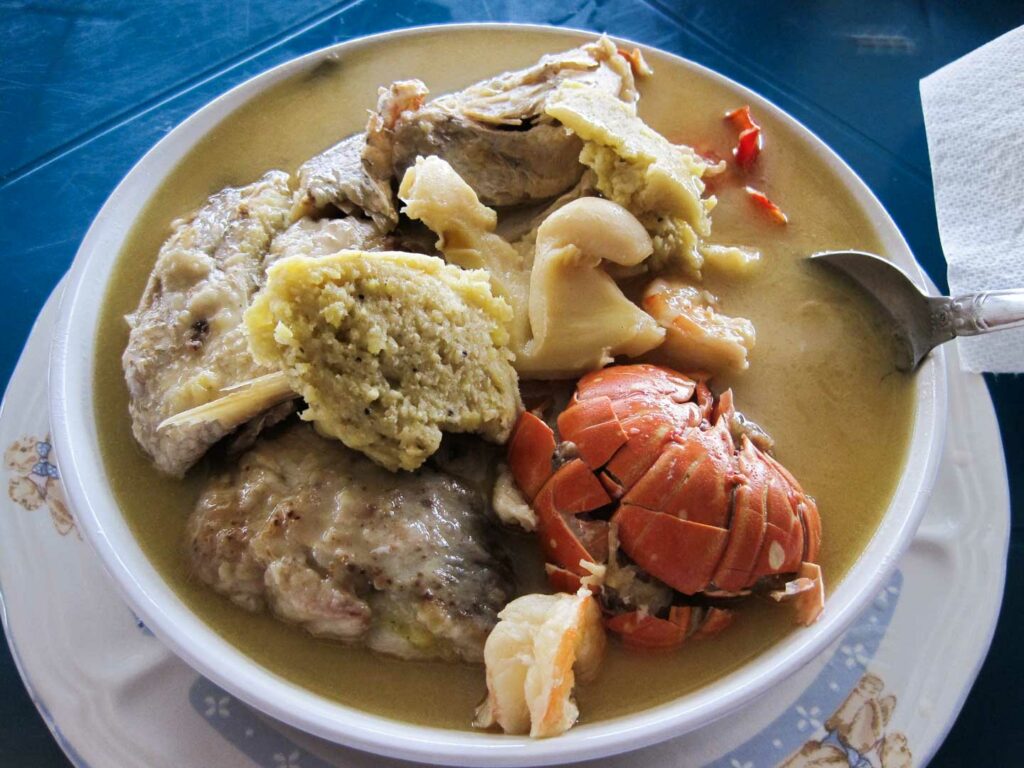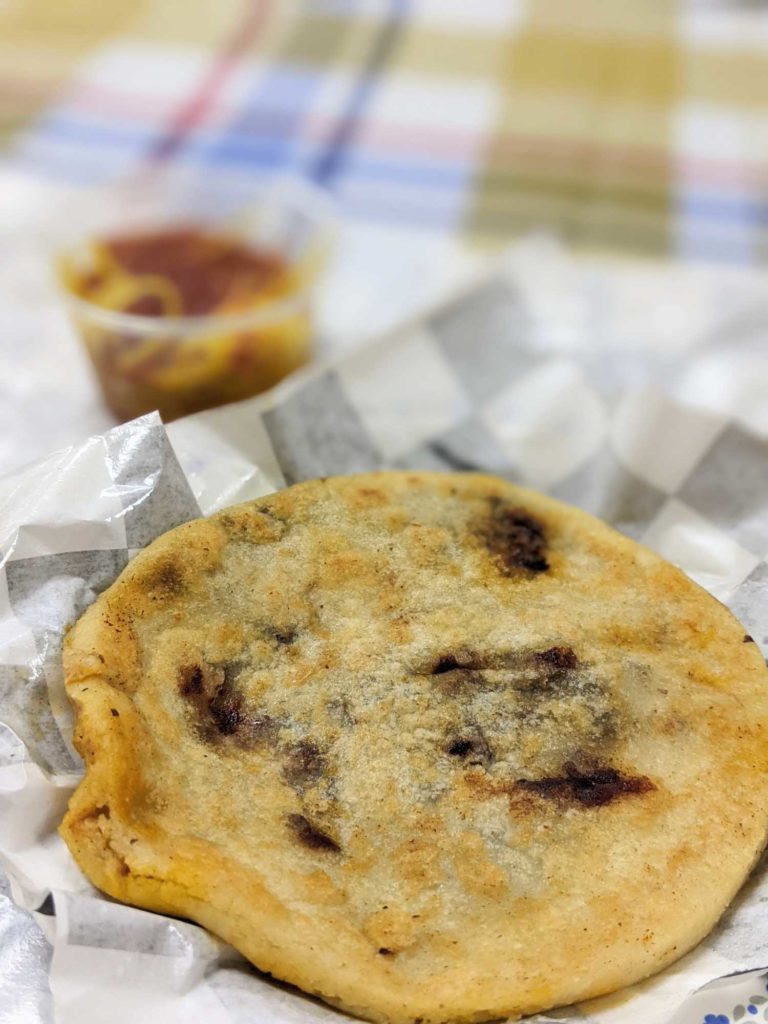Forget cereal or pancakes, breakfast in Honduras is a fantastic way to begin the day. Here are 15 delicious morning foods in Honduras that will make you fall in love with this Central American country’s food culture.
Honduran food is different from its neighbors and I really fell for it while visiting. It may be the best meal of the day.
While the country is small there are over 9 million people spread across diverse regions, from Caribbean coastlines to mountainous highlands.
There are countless ways to enjoy corn, beans, cheese and fresh ingredients.
Traditional Honduran Food
For Hondurans, breakfast is the most important meal and it starts early in the morning. You’ll find families gathering around tables loaded with warm tortillas, fresh cheese and steaming coffee.
Hondurans love to eat at home, but don’t worry street vendors and small comedores also serve incredible morning meals.
And don’t be surprised to see construction workers and office employees lined up at the same small stall for their daily baleadas and coffee. Street food is for everyone.
Honduras Culinary Influences & Traditions
Honduran breakfast reflects the country’s rich cultural mix. Indigenous Lenca and Maya communities contributed corn-based staples like tortillas and tamales.
Spanish invasion brought rice, pork and cattle, creating dishes like chorizo con huevos and fresh cheese.
The Garífuna people along the Caribbean coast add African and indigenous flavors with coconut, plantains and seafood. Their breakfast dishes like machuca and pan de coco are completely different from highland foods.
You can see regional difference when you travel:
- Mountain areas focus on hearty bean and corn dishes.
- Coastal regions use more coconut and seafood.
- Northern regions near Guatemala share similar tamale traditions.
- Southern areas near El Salvador make pupusas their own way.
Breakfast in Honduras
Baleadas | Flour Tortilla with Beans and Cheese
Baleadas are the most popular Honduran breakfast food. You’ll find them everywhere from street carts to fancy hotels.
A baleada starts with a thick, soft flour tortilla. The vendor spreads refried beans across the surface, then adds crumbled fresh cheese and thick sour cream.
But most people want more. Baleadas can include scrambled eggs, avocado, chorizo, chicken or beef. Some places add pickled jalapeños or hot sauce. The tortilla gets folded in half and served hot.
This dish comes from northern Honduras, especially around San Pedro Sula. Legend says a woman named Doña Teresa sold them from a cart in the 1960s. People called her “La Baleada” because she had been shot once. Her food became so popular that her nickname became the food’s name.
Sopa de Frijoles con Huevo | Bean Soup with Egg
Sopa de frijoles con huevo transforms leftover beans into a delicious breakfast soup.
It is a mix of mashed and whole cooked red or black beans combined with onions, garlic and sometimes diced tomatoes or bell peppers. Often it includes a raw egg cracked directly into each bowl of hot soup, where it cooks gently from the heat.
The egg creates ribbons of cooked protein throughout the soup, similar to Chinese egg drop soup. Some families prefer to scramble the egg separately and add it on top.
This breakfast is especially popular during cooler months in Honduras’s highland regions. It’s warming, protein-rich and uses simple ingredients that most families keep on hand.
Desayuno Típico | Traditional Honduran Breakfast
Desayuno típico is what most Hondurans eat when they want a complete breakfast. It’s a full plate that keeps you satisfied until lunch.
The name literally means a typical breakfast.
The plate always includes scrambled or fried eggs, refried black beans, fresh white cheese, fried sweet plantains and warm corn tortillas.
Some places add a small serving of rice or a slice of avocado.
Tortillas con Quesillo | Warm Tortillas with Soft Cheese
This simple breakfast shows how good food doesn’t need to be complicated.
Fresh corn tortillas come hot off the comal, still steaming and soft. The cook adds quesillo, a mild fresh cheese similar to mozzarella, and folds the tortilla in half. The cheese melts slightly from the tortilla’s heat.
Some families make their own quesillo from fresh cow’s milk. The cheese has a clean, milky flavor that complements the corn tortillas perfectly. A sprinkle of salt brings out both flavors.
Enchiladas Hondureñas | Fried Tortilla with Beef and Egg
Don’t confuse these with Mexican enchiladas. Honduran enchiladas are completely different and much crunchier.
And they actually look more like a breakfast taco or tostada in Mexico.
They start with a small corn tortilla that gets fried until golden and crispy. The cook tops it with seasoned ground beef, then adds a fried egg on top.
The best ones also have shredded cabbage, diced tomatoes, pickled onions and a sprinkle of cheese.
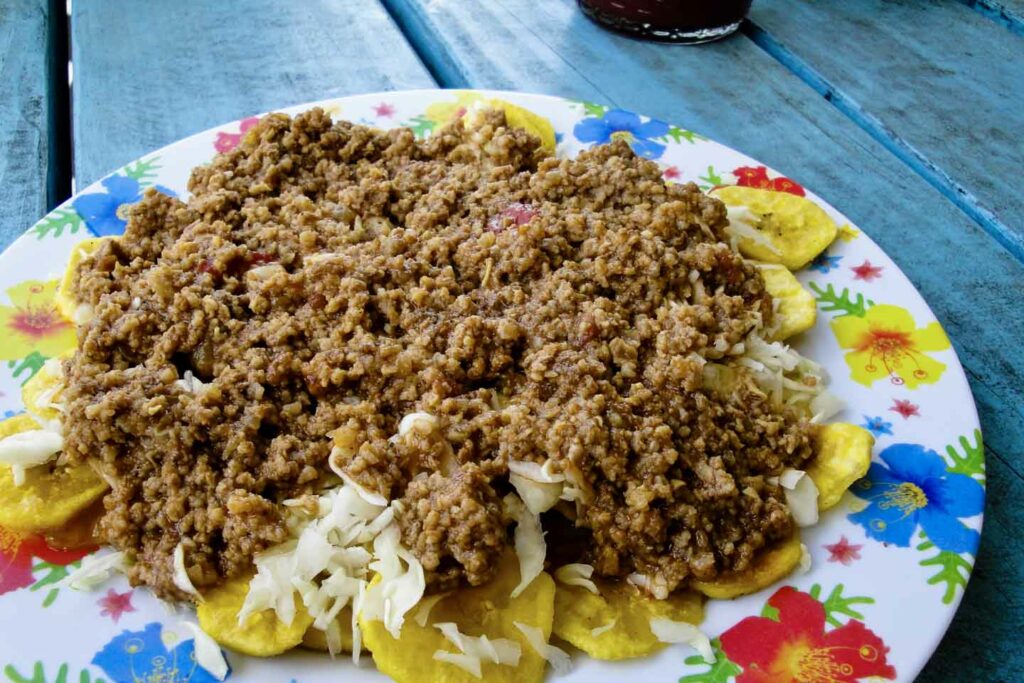
Tajadas con Huevo | Fried Plantains with Egg
Tajadas con huevo combines two ingredients that Hondurans love: green plantains and eggs.
It’s a simple dish of fried sliced green plantains. The plantains have a mild, starchy flavor that pairs perfectly with rich scrambled eggs or fried eggs on top.
Some cooks add onions and bell peppers to the scrambled eggs. I splurged on the tajadas above that also had beef and cabbage.
It was a lot to eat for breakfast. I recommend sharing.
This Honduran breakfast is especially popular along the Caribbean coast where plantains grow year-round. Garífuna families often add coconut milk to the eggs for extra richness and flavor.
The dish provides good energy for manual laborers and farmers who need substantial food to start their day. It’s affordable, filling and uses ingredients that keep well without refrigeration.
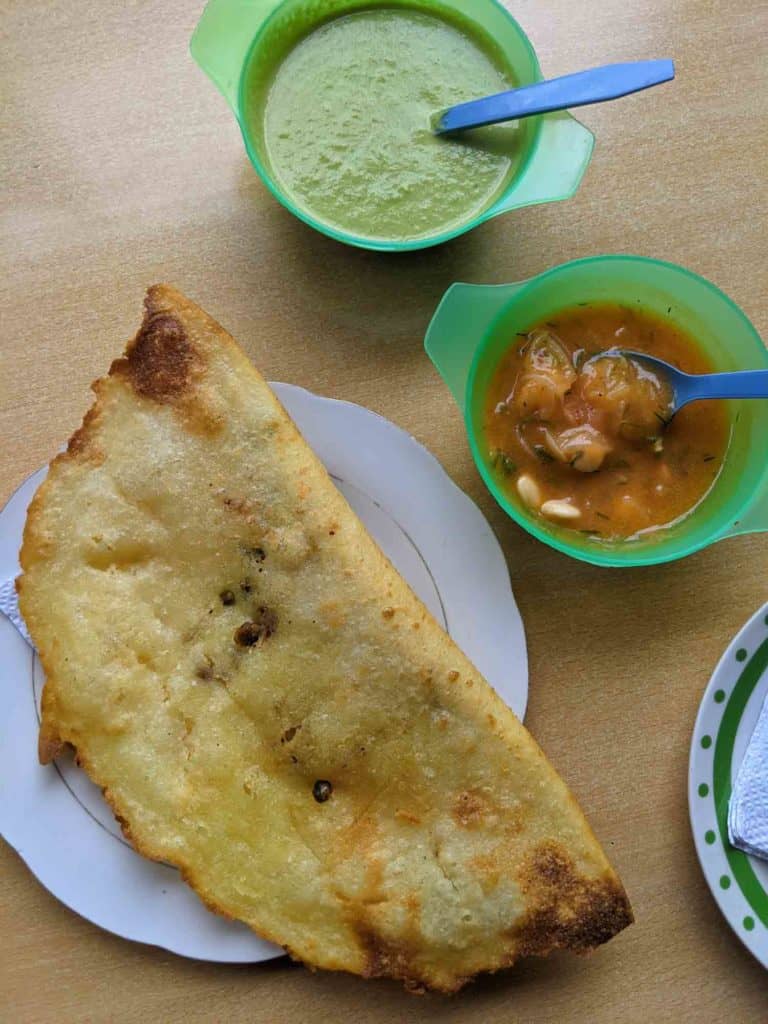
Pastelitos de Carne | Fried Meat Pockets
Pastelitos are small fried pockets that make a perfect grab-and-go breakfast. They’re popular with people who need to eat quickly before work and you may know them in other countries as empanadas.
The outer shell is made from corn masa mixed with a little flour for tenderness. The meat filling usually includes beef, onions, bell peppers and spices like cumin and black pepper.
Some cooks add a small piece of hard-boiled egg or a few raisins for sweetness, but personally I prefer it without.
Unique Honduran Drinks
Street vendors sell them hot from large frying pans. You can eat them with your hands, making them perfect for people walking to work or catching a bus.
Similar fried pockets exist throughout Central America, but the Honduran version tends to be smaller and uses more beef than chicken or pork.
Tamales Hondureños | Corn Masa with Pork
Tamales hondureños are weekend breakfast food for special occasions and family gatherings.
Making tamales requires time and many hands. Families gather on Saturday evenings to prepare masa from ground corn, lard and broth. The filling includes pork shoulder, chicken, rice, vegetables and spices wrapped in banana leaves.
Tamales steam for several hours overnight. By Sunday morning, they’re ready to unwrap and eat with coffee and fresh bread.
The banana leaves give them a subtle herbal flavor that aluminum foil can’t match.
Different regions make tamales differently. Northern tamales tend to be larger with more meat. Southern versions often include more vegetables and rice.
Fruits in Honduras
Montuca | Spiced Meat Tamale
Montuca is another type of tamale popular in central Honduras. It’s smaller than regular tamales and has a spicier filling.
The masa is made from white corn and forms a thinner wrapper than other tamales. Inside, the filling includes seasoned pork or beef with onions, peppers and hot spices.
Montuca gets wrapped in corn husks instead of banana leaves. This gives them a different texture and allows the flavors to concentrate more intensely.
These tamales are especially popular during Christmas season in Honduras, but many families make them year-round for Sunday breakfast.
They’re smaller than regular tamales, so people often eat two or three with coffee.
The name “montuca” comes from an indigenous word, showing how pre-Columbian foods continue in modern Honduran cooking.
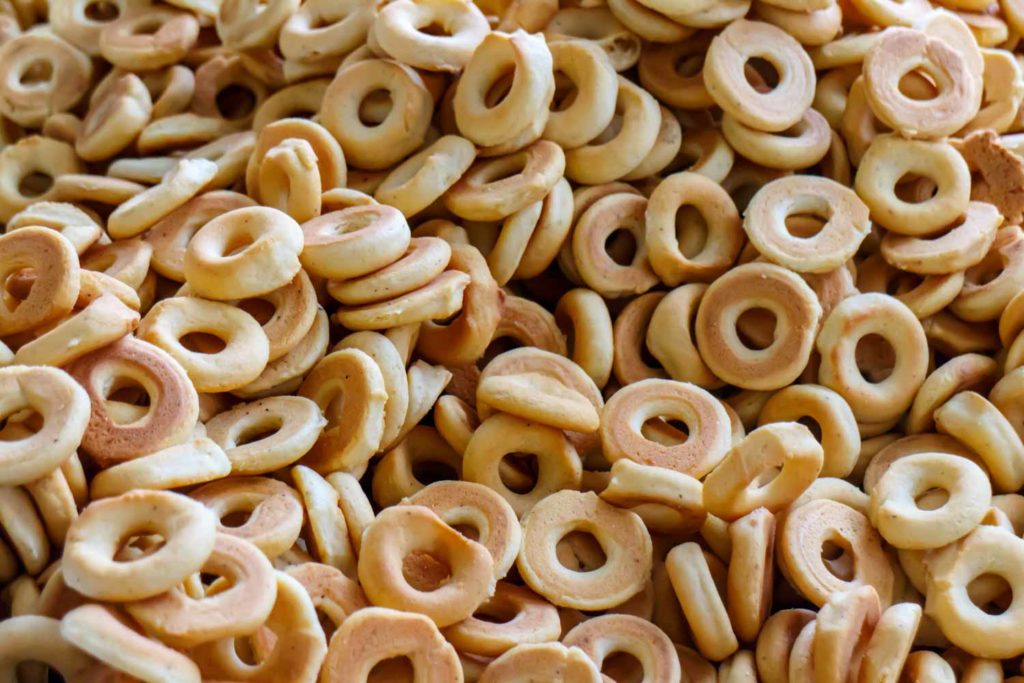
Rosquillas con Café | Cornmeal Rings with Coffee
Rosquillas are crunchy cornmeal cookies that Hondurans love to dunk in their morning coffee.
These ring-shaped treats are made from corn flour, cheese, eggs and a touch of sugar.They have a slightly sweet, cheesy flavor and a firm texture that softens when dipped in hot coffee.
Different regions make rosquillas with slight variations. Some use more cheese for a savory version. Others add extra sugar for sweetness. Coastal areas sometimes include coconut in the recipe.
They are also a popular dessert in Nicaragua.
Huevos con Chorizo | Eggs with Spiced Sausage
Huevos con chorizo brings Spanish influence to the Honduran breakfast table.
Honduran chorizo is different from Mexican or Spanish versions. It’s made with pork, garlic, vinegar and paprika, but the seasoning is milder and less spicy.
Most families serve this with warm tortillas, refried beans and fresh cheese. Coffee is always included to cut through the richness of the eggs and sausage.
Machuca | Garífuna Plantain and Fish Stew
Machuca is a traditional Garífuna breakfast found along Honduras’s Caribbean coast. This dish reflects the African, indigenous and Caribbean influences in Garífuna culture.
The base is mashed green plantains, similar to Caribbean mofongo. The plantains get boiled until soft, then mashed with garlic and salt in a large wooden mortar called a pilón.
The stew includes fresh fish, usually snapper or sea bass, cooked in coconut milk with onions, peppers and cilantro. The coconut milk makes the stew rich and slightly sweet, balancing the mild fish flavor.
Everything gets served together in a bowl, with the mashed plantains forming a base for the fish stew. Some families add yuca or ñame (tropical tubers) to make it more filling.
This breakfast is unique to Garífuna communities in places like La Ceiba, Tela and Roatán. You won’t find authentic machuca in inland Honduras.
Yuca con Chicharrón | Cassava with Crispy Pork
Yuca con chicharrón is a hearty breakfast of crispy pork over the boiled yuca. Some cooks add a simple tomato and onion salsa on top. Others serve it with pickled vegetables or hot sauce.
This dish is popular throughout Honduras, but especially in rural areas where families often raise their own pigs. The cassava grows easily in tropical climates and stores well without refrigeration.
Pupusas Hondureñas | Griddled Stuffed Tortillas
Pupusas in Honduras are different from the famous Salvadoran version, though both countries claim to have invented them.
Honduran pupusas are made from corn masa formed into thick discs, then stuffed with refried beans, cheese, or both. It is cooked on a hot griddle until golden brown on both sides.
They’re served with curtido, a lightly pickled cabbage slaw, and thin tomato salsa. The contrast between the warm, cheesy pupusa and cool, tangy curtido makes each bite interesting.
This Honduran breakfast is especially popular on weekends when families have more time to prepare the masa and fillings from scratch.
Pan de Coco | Garífuna Coconut Bread
Pan de coco is a soft, slightly sweet coconut bread from Garífuna communities along the Caribbean coast.
This bread is made with fresh coconut milk, coconut oil and grated coconut meat. The dough includes eggs and a touch of sugar, creating a rich, tender crumb with subtle coconut flavor throughout.
Traditional recipes use coconut oil instead of butter. Some bakers add a little rum or vanilla for extra flavor.
Pan de coco is often eaten warm from the oven with butter and jam, or dunked in strong coffee. It keeps well for several days, making it practical for families and fishing communities.
This bread reflects the Garífuna community’s connection to coconut palms, which grow abundantly along Honduras’s Caribbean shore.
You’ll find the best versions in Garífuna towns like Tela, La Ceiba and Trujillo.
Honduran Enchiladas (c) stu_spivak, Honduran tamale (c) kristin klein, machuca (c) Darrell,
